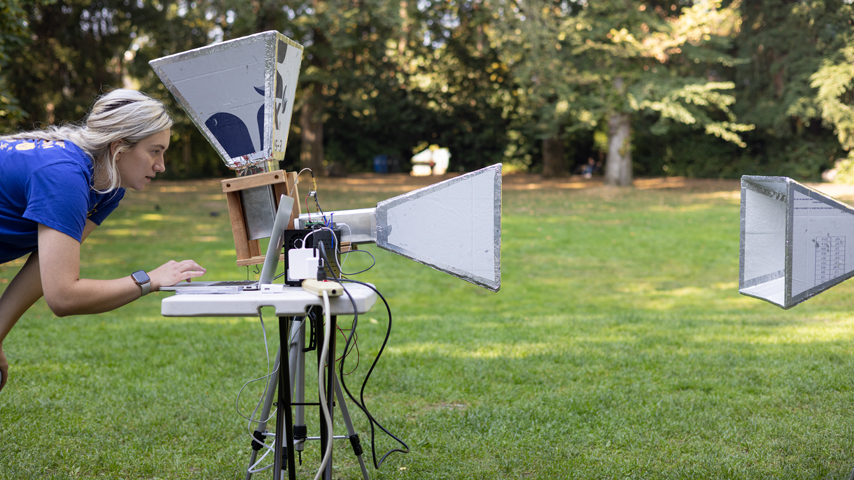Passive Wireless System Is Powered by Electronic Noise
Passive Wireless System Is Powered by Electronic Noise


Researchers have created a new wireless communication system that can transmit and receive data without the need for radio frequency signals, saving significant amounts of energy.
Wireless communication systems typically depend on radio waves to transmit information back and forth. Even though these systems can send large amounts of data over long distances, the downside is that power is consumed to generate radio waves, which can become costly for a device in terms of energy.
Now, a team of researchers at the University of Washington led by electrical and computer engineering professor Joshua Smith has successfully demonstrated a prototype of a passive wireless communication system that enables devices to send and receive data without relying on externally generated or ambient radio frequency signals. Instead, the data travels via the ever-present electronic noise that exists in circuitry.
In most use scenarios, background noise is usually regarded as a nuisance, or even a problem. For example, it can drown out weak signals. That’s not the case for Smith’s innovative system.
Become a Member: How to Join ASME
“In general, when we think about noise in wireless communication, it’s often viewed as interference,” said Zerina Kapetanovic, a Ph.D. student and team member who is now an assistant professor of electrical engineering at Stanford University. “We’re actually showing just the opposite here, that this particular type of noise can be used to enable communication.”
The prototype utilizes the electronic noise generated by thermal agitation of charge carriers in circuits—also known as Johnson noise—to transmit data.
The research idea, she noted, was actually inspired by radio astronomy. Radio astronomers observe celestial objects that have varying brightness temperatures. For example, the Earth is “hot” while the “sky” is cold. “We took inspiration from this,” Kapetanovic said. “Instead of using these techniques for sensing, we used them to enable wireless communication.”
The experiment was designed to attempt the transmission of information by selectively connecting and disconnecting a “hot” impedance-matched resistor to an antenna. This modulates microwave frequency Johnson noise emitted by the antenna and enables bits of information to be transmitted and received.
Take Our Quiz: Sound Engineering
The data transmission hardware is similar to that of an RFID tag (but without the need for RF signals). An interesting feature is that all components of the system are at the same physical temperature, but it can function because they have different noise temperatures. A side benefit is that the elimination of the RF carrier simplifies the system architecture and the reader hardware.
While the majority of the hardware consisted of off-the-shelf components, the team actually built its own horn antennas. “We followed open-source designs on how to construct a horn antenna that operates at 1.42GHz, using home insulation board and a paint can,” said Kapetanovic.> “We built many antennas, as well as antennas of different sizes.”
Their experiments showed that this method of wireless communication works at room temperature, transmitting data at rates of up to 26 bits per second over a distance of 7.3 meters. This communication method also operates at very low power, similar to that of an RFID tag.
This experiment is the first step in proving the viability of this innovative wireless transmission method. Future work will target boosting data rates and transmission distance. Even at short-range, the technology holds great potential.
“I think that short-range applications are probably where this method of wireless communication has the chance of greatest impact,” Smith said. “These could be things like implanted electronics for medical purposes, where the key is just to get the data outside the body or applications such as contactless payment or ID cards, where you’re only sending data a short distance.”
More for You: Designing a Golden Eye for the Sky
Other possibilities are using this system in the design of smart home security systems, appliances, smart lighting fixtures, and thermostats. Still another could be stealth communication” because devices modulating Johnson noise do not rely on pre-existing radio signals and can operate on any frequency. The system could be a method used to send information back and forth without being observed.
But perhaps one of the biggest benefits of this new form of wireless communication is that it opens a new line of research possibilities for engineers and scientists.
“There are many other thermal noise sources that could be utilized to enable this form of wireless communication, making this an exciting area of research to continue exploring," said Kapetanovic. "For example, how can we improve the performance of the system in terms of communication range and throughput? It will also be interesting to explore the application space to determine the practical use cases. For example, could this method of wireless communication be used for implantable devices, contactless credit cards, or stealth communication?"
Mark Crawford is a science and technology writer in Corrales, N.M.




